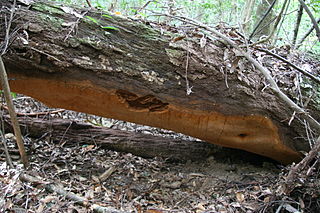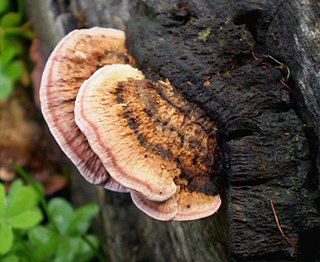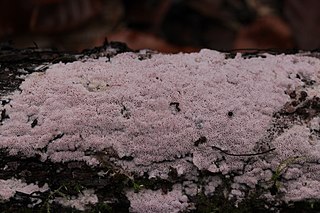Related Research Articles

Haploporus is a genus of poroid fungi in the family Polyporaceae.

Skeletocutis is a genus of about 40 species of poroid fungi in the family Polyporaceae. The genus has a cosmopolitan distribution, although most species are found in the Northern Hemisphere. It causes a white rot in a diverse array of woody substrates, and the fruit bodies grow as a crust on the surface of the decaying wood. Sometimes the edges of the crust are turned outward to form rudimentary bracket-like caps.

Phellinus ellipsoideus is a species of polypore fungus in the family Hymenochaetaceae, a specimen of which produced the largest fungal fruit body ever recorded. Found in China, the fruit bodies produced by the species are brown, woody basidiocarps that grow on dead wood, where the fungus feeds as a saprotroph. The basidiocarps are perennial, allowing them to grow very large under favourable circumstances. They are resupinate, measuring 30 centimetres (12 in) or more in length, though typically extending less than a centimetre from the surface of the wood. P. ellipsoideus produces distinct ellipsoidal spores, after which it is named, and unusual setae. These two features allow it to be readily differentiated microscopically from other, similar species. Chemical compounds isolated from the species include several steroidal compounds. These may have pharmacological applications, but further research is needed.
Skeletocutis brevispora is a species of poroid crust fungus in the family Polyporaceae. It was described as new to science in 1998 by Finnish mycologist Tuomo Niemelä.
Haploporus thindii is a species of poroid crust fungus in the family Polyporaceae. Found in China and India, it causes a white rot in woody substrates.
Haploporus cylindrosporus is a species of poroid crust fungus in the family Polyporaceae. Found in China, it causes a white rot in decomposing angiosperm wood.
Fibroporia albicans is a species of poroid crust fungus in the family Fomitopsidaceae. It causes a brown rot. The fungus was described in 2015 as a species new to science, based on collections made in Jiangxi and Xizang Provinces, China. It is one of five Fibroporia species recorded in China.
Skeletocutis yunnanensis is a species of poroid crust fungus in the family Polyporaceae that was described as a new species in 2016. The type specimen was collected in northern Yunnan Province, southwestern China, where it was found growing on decaying angiosperm wood in a temperate forest.
Skeletocutis subvulgaris is a species of poroid, white rot fungus in the family Polyporaceae. Found in China, it was described as a new species in 1998 by mycologist Yu-Chen Dai. It was named for its resemblance to Skeletocutis vulgaris. The type collection was made in Hongqi District, Jilin Province, where it was found growing on the rotting wood of Korean pine.

Rhodofomitopsis is a genus of four species of poroid fungi in the family Fomitopsidaceae. It was circumscribed by Chinese mycologists in 2016, with Rhodofomitopsis feei as the type species. Rhodofomitopsis is a distinct lineage of fungi that were previously placed in genus Fomitopsis. The generic name alludes to this resemblance to Fomitopsis and the violaceous pore surface.
Fragiliporia is the sole genus in the fungus family Fragiliporiaceae. It contains the poroid crust fungus Fragiliporia fragilis, described as new to science by Chinese mycologists in 2014. The type specimen of this fungus was discovered growing on a rotting stump of alder in the Gaoligongshan National Nature Reserve in Yunnan. The specific epithet fragilis refers to the brittle fruit bodies of the fungus. Molecular phylogenetics shows that the fungus is in an isolated position in the Polyporales, distinct from the six previously identified clades in this order. In a later study (2017), Fragiliporia was recovered in a phylogenetically isolated position as sister to Candelabrochaete africana.
Buglossoporus eucalypticola is a species of poroid fungus in the family Fomitopsidaceae. It was described as a new species in 2016 by mycologists Mei-Ling Han, Bao-Kai Cui, and Yu-Cheng Dai. The type specimen was collected in the Danzhou Tropical Botanical Garden, in Danzhou, China. It was growing on a dead Eucalyptus tree. The fruit body has a fan-shaped or semicircular cap that projects up to 10 cm (3.9 in), 6.5 cm (2.6 in) wide, and 7 mm (0.3 in) thick at its base. The surface colour when fresh is peach to brownish orange, but when dry becomes clay-pink to cinnamon. The pore surface on the cap underside is initially white before becoming pinkish buff or clay-buff to dark brown. B. eucalypticola causes a brown rot in its host.
Ceriporia inflata is a species of crust fungus in the family Irpicaceae. It was described as new to science in 2013 by mycologists Bi-Si Jia and Bao-Kai Cui. The fungus is distinguished macroscopically from other Ceriporia species by its relatively large pores, and microscopically by its hyphae, which swell in KOH. It is this latter feature for which the fungus is named. The type specimen of C. inflata was collected from Qiongzhong County, where it was found growing on rotten angiosperm wood. It has also been recorded from Fenyi County in Jiangxi.
Perenniporia minor is a poroid fungus in the family Polyporaceae. It was described as a new species in 2008 by mycologists Yu-Cheng Dai and Hong-Xia Xiong. The type specimen was collected in Changbaishan Nature Reserve in Jilin province, where it was found growing on fallen angiosperm branches at an altitude of 1,100 metres (3,600 ft).
Neodatronia is a genus of two species of poroid crust fungi in the family Polyporaceae. It was circumscribed in 2014 by Chinese mycologists Bao-Kai Cui, Hai-Jiao Li, and Yu-Cheng Dai as a segregate genus from Datronia. Neodatronia fungi differ microscopically from Datronia by having moderately to frequently branched skeleto-binding hyphae in the context, and by their somewhat smaller spores.
Leifiporia is a genus of two species of poroid white rot crust fungi in the family Polyporaceae. The genus was circumscribed by Chinese mycologists in 2016 to accommodate the type species Leifiporia rhizomorpha.
Haploporus septatus is a species of poroid crust fungus in the family Polyporaceae. Found in China, it causes a white rot in decomposing angiosperm wood.
Datroniella tropica is a species of crust fungus in the family Polyporaceae. Found in southwestern China, it was described as a new species in 2014 by mycologists Bao-Kai Cui, Hai J. Lee, and Yu-Cheng Dai, who placed it in the new genus Datroniella. The type collection was made in Tongbiguan Nature Reserve, where the fungus was found growing on a fallen angiosperm branch. The specific epithet tropica refers to its distribution in tropical China.

Ceriporia excelsa is a species of crust fungus in the family Irpicaceae. It is found in Europe and North America, where it typically grows on dead hardwood. It has also been recorded from China.
Skeletocutis nothofagi is a rare species of poroid crust fungus in the family Polyporaceae that is found in South America. It has been proposed for inclusion in the IUCN Red List of Threatened Species due to its highly restricted distribution and rare occurrence.
References
- 1 2 3 4 Cui, Bao-Kai; Dai, Yu-Cheng (2008). "Skeletocutis luteolus sp. nov. from southern and eastern China". Mycotaxon. 104: 97–101.